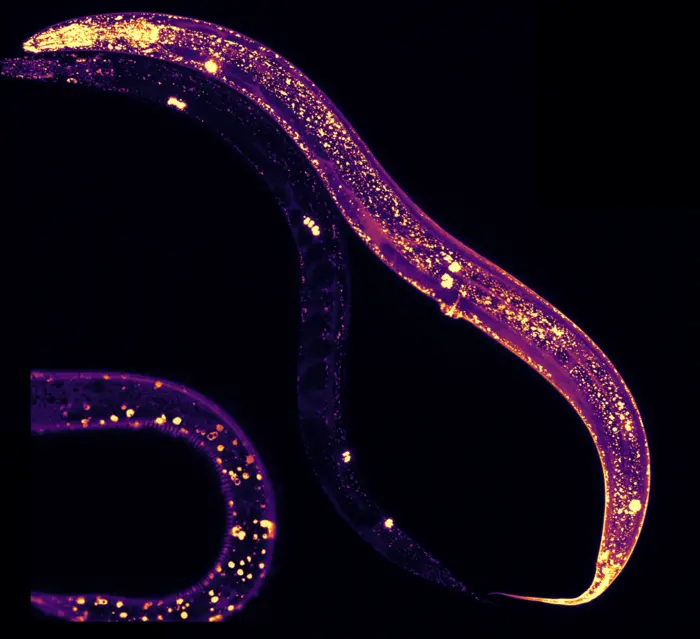Researchers at McMaster University have uncovered a previously unrecognized function of a protein that helps protect cells, potentially leading to new treatments for age-related conditions and promoting healthier aging.
 C. Elegans examined under a microscope. The yellow and purple dots are the regions where MANF protein is located. Image Credit: McMaster University
C. Elegans examined under a microscope. The yellow and purple dots are the regions where MANF protein is located. Image Credit: McMaster University
The research team identified that a class of protective proteins called MANF is involved in maintaining cellular efficiency and proper function.
These findings were published in the journal Proceedings of the National Academy of Sciences.
Cells produce proteins and dispose of them once they have fulfilled their roles. This ongoing maintenance is referred to as cellular homeostasis, but the efficiency of this process decreases as we age.
Cells can create proteins incorrectly, and the cleanup process can become faulty or overwhelmed. Consequently, proteins may aggregate, causing a harmful buildup that has been associated with diseases like Alzheimer's and Parkinson's.
If the cells are experiencing stress because this protein aggregation has started, the endoplasmic reticulum, which is where proteins are made and then released, gets the signal to stop making these proteins. If it can’t correct the problem, the cell will die, which ultimately leads to degeneration of the neurons and then neurodegenerative diseases that we see.”
Bhagwati Gupta, Professor, Biology, McMaster University
Earlier research, including a study conducted at McMaster, demonstrated that MANF shields cells from heightened stress. To investigate how this protection works, the team studied microscopic worms called C. elegans. They developed a system that allowed them to control the levels of MANF in these organisms.
“We could literally see where MANF was expressed in the worms because they are translucent. We could see it in all different tissues. Within these tissues, MANF was present in structures known as lysosomes which are associated with lifespan and protein aggregation,” states Shane Taylor, now a Post-Doctoral Fellow at the University of British Columbia who worked on the project for his PhD while at McMaster.
The researchers found that MANF is crucial in the cellular disposal process by assisting in the breakdown of accumulated proteins, which helps maintain healthier, uncluttered cells.
Elevating MANF levels also triggers the cell’s natural clean-up mechanisms, enabling cells to function more effectively for a longer period.
Although our research focused on worms, the findings uncover universal processes. MANF is present in all animals, including humans. We are learning fundamental and mechanistic details that could then be tested in higher systems.”
Shane Taylor, Post-Doctoral Fellow, University of British Columbia
To develop MANF as a potential therapeutic option, researchers aim to identify the other molecular components that interact with MANF
Discovering MANF’s role in cellular homeostasis suggests that it could be used to develop treatments for diseases that affect the brain and other parts of the body by targeting cellular processes, clearing out these toxic clumps in cells, and maintaining their health.”
Bhagwati Gupta, Professor, Biology, McMaster University
Gupta concludes, “The central idea of aging research is basically can we make the processes better and more efficient. By understanding how MANF works and targeting its function, we could develop new treatments for age-related diseases. We want to live longer and healthier. These kinds of players could help that.”
Source:
Journal reference:
Taylor, S. K. B., et al. (2024) The neurotrophic factor MANF regulates autophagy and lysosome function to promote proteostasis in Caenorhabditis elegans. Proceedings of the National Academy of Sciences. doi.org/10.1073/pnas.2403906121.